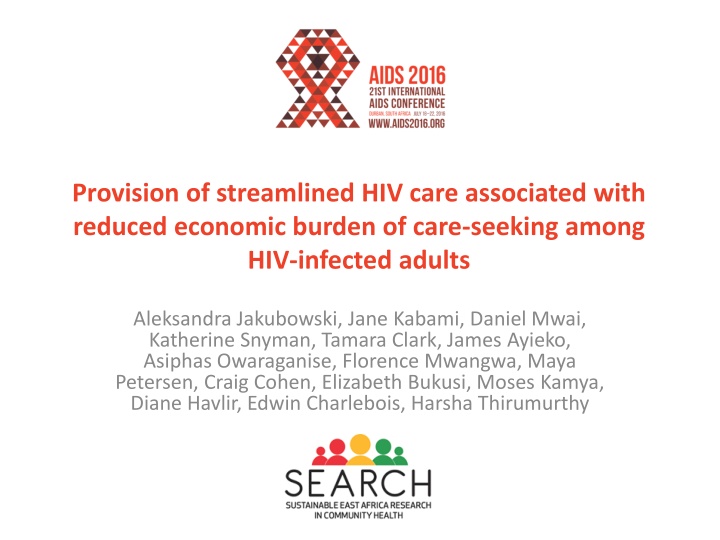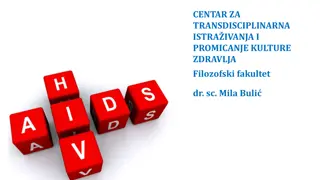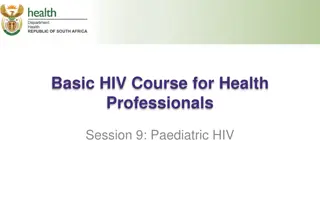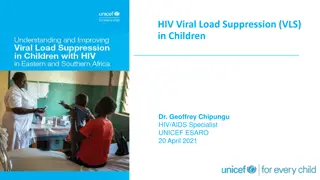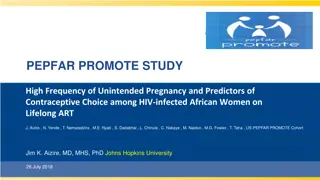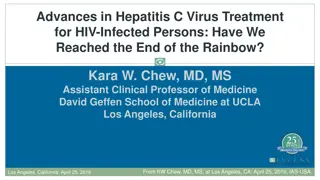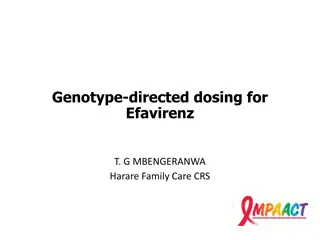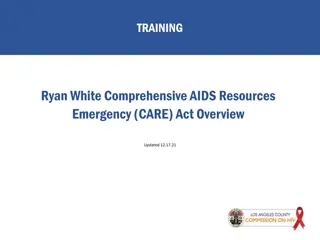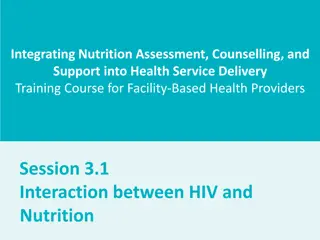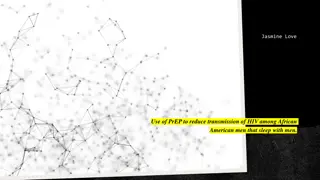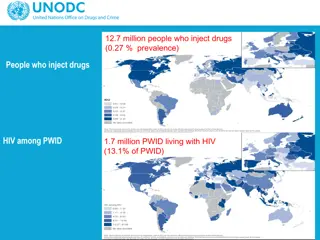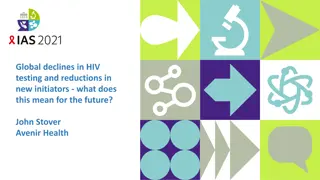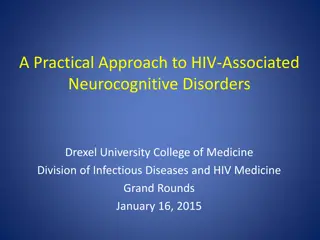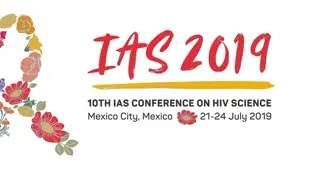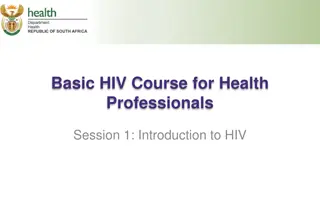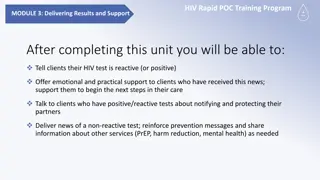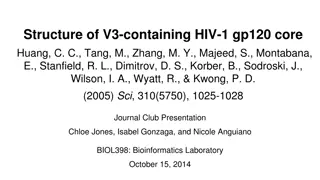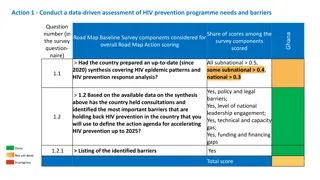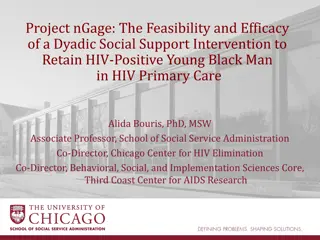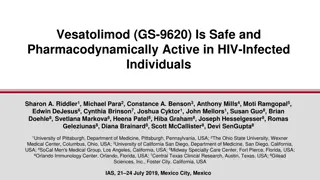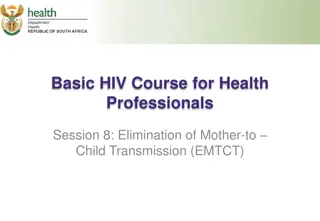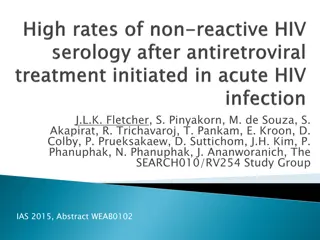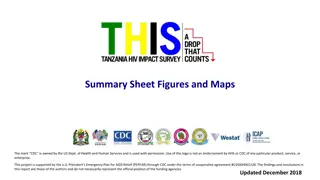Impact of Streamlined HIV Care on Economic Burden among Infected Adults
Streamlined HIV care models aim to reduce the economic burden faced by HIV-infected adults by minimizing healthcare costs and improving access to care. The SEARCH trial in Kenya and Uganda implemented population-based testing and supported linkage to antiretroviral therapy (ART) regardless of CD4 counts. The streamlined care model focused on efficient visits, patient-centered care, telephone hotlines, appointment reminders, and viral load counseling. Longitudinal surveys assessed changes in healthcare costs among households with HIV-positive adults, showing potential benefits of streamlined care in reducing financial strain on patients seeking treatment.
Download Presentation

Please find below an Image/Link to download the presentation.
The content on the website is provided AS IS for your information and personal use only. It may not be sold, licensed, or shared on other websites without obtaining consent from the author.If you encounter any issues during the download, it is possible that the publisher has removed the file from their server.
You are allowed to download the files provided on this website for personal or commercial use, subject to the condition that they are used lawfully. All files are the property of their respective owners.
The content on the website is provided AS IS for your information and personal use only. It may not be sold, licensed, or shared on other websites without obtaining consent from the author.
E N D
Presentation Transcript
Provision of streamlined HIV care associated with reduced economic burden of care-seeking among HIV-infected adults Aleksandra Jakubowski, Jane Kabami, Daniel Mwai, Katherine Snyman, Tamara Clark, James Ayieko, Asiphas Owaraganise, Florence Mwangwa, Maya Petersen, Craig Cohen, Elizabeth Bukusi, Moses Kamya, Diane Havlir, Edwin Charlebois, Harsha Thirumurthy
Background Despite free treatment, patients face various costs associated with healthcare utilization Transportation, time away from work, out-of-pocket expenditures Alternative models of delivering ART have potential to reduce economic burden of receiving care In communities that began receiving streamlined HIV care, we examined changes in healthcare costs incurred by patients
SEARCH trial SEARCH: HIV test-and-treat cluster randomized trial in Kenya and Uganda (NCT:01864603) Key interventions Population-based testing Supported linkage ART irrespective of CD4 Streamlined HIV care UGANDA KENYA Tororo Mbarara Nyanza
SEARCH Streamlined Care Model 1. Efficient Visits for Patients and Staff 2. Patient-centered approach to care ART start at first clinic visit as indicated Triage by nurse or other extender at all follow-up visits Welcoming environment Fostering trust, connection, and a sense of investment in the patient Flexible clinic hours Tiered tracking Multi-disease chronic care model Clinic visits and ART dispensation every 3 months rather than every 1-2 months Integration of services: HIV care, NCD care, general medical care 3. Telephone hotline access for patients 4. Appointment reminders by phone/SMS 5. Viral Load Counseling Structured format for discussion of undetectable and detectable results Easy triage of medical questions One week to few days in advance Appointment/scheduling logistics for retention Retention tool
Methods Longitudinal surveys conducted among a random sample of households with HIV+ and HIV- adults 200 households enrolled in each community, revisited each year 100 with & without HIV+ adults July 2013 Aug. 2014: after SEARCH baseline testing Oct. 2014 Sept. 2015: follow-up year 1
Methods Survey questionnaires obtained information on various dimension of healthcare costs Adapted from Living Standards Measurement Surveys Survey data from linked to SEARCH data on HIV status and ART status of individuals
Outcomes Outcomes selected to characterize multiple dimensions of healthcare burden Number of hours spent seeking healthcare in past month Number of hours lost from work in past month Reported being hospitalized in past year Healthcare expenditures in past month (US$)
Statistical analyses Baseline data analyzed to compare outcomes for various sub-populations HIV+ and HIV- adults Trends between baseline and follow-up year 1 analyzed for HIV+ adults receiving ART Regression models that included data for HIV- adults were used to adjust for temporal patterns Values above 95th percentile replaced with 95th percentile to limit effect of outliers
Adult participants in household survey intervention communities HIV- adults 4,562 at baseline 4,229 at follow-up year 1 HIV+ adults on ART 1,324 on ART at baseline 1,707 on ART at follow-up year 1
Non-financial costs are a significant component of healthcare burden At baseline, health expenditures and time seeking care 30-50% higher for HIV+ adults
Among all HIV+ adults receiving ART, economic burden of healthcare tended to decline over time Data for adults receiving ART
Time spent seeking healthcare SW Uganda E Uganda -2.76*** (0.72) Kenya 0.12 (0.38) All regions -0.92*** (0.28) On ART * Follow-up year 1 -0.94** (0.36) Observations Robust standard errors in parentheses. P-value notation: *** p<0.001, ** p<0.01, * p<0.05 3,760 3,797 3,865 11,422 Relative to baseline levels for those on ART, ~40% decline in hours seeking care
Time lost from work SW Uganda -1.66 (1.27) E Uganda -2.98 (2.53) Kenya -1.99 (1.69) All regions -2.46* (1.05) On ART * Follow-up year 1 Observations Robust standard errors in parentheses. Models were adjusted for gender, age, age, education, wealth, community and month of interview. Outliers censored at 95th percentile. P-value notation: *** p<0.001, ** p<0.01, * p<0.05 3,760 3,797 3,865 11,422 Relative to baseline levels for those on ART, ~25% decline in hours lost from work
Healthcare expenditures (US$) SW Uganda E Uganda -0.95* (0.45) Kenya 0.18 (0.40) All regions -0.64** (0.24) On ART * Follow-up year 1 -1.31*** (0.38) Observations Robust standard errors in parentheses. . Models were adjusted for gender, age, age, education, wealth, community and month of interview. Outliers censored at 95th percentile. P-value notation: *** p<0.001, ** p<0.01, * p<0.05 3,760 3,797 3,864 11,421 Relative to baseline levels for those on ART, 47% reduction in healthcare expenditures
Probability of hospitalization in past 12 months SW Uganda E Uganda -0.04 (0.03) Kenya -0.02 (0.02) All regions -0.03* (0.01) On ART * Follow-up year 1 -0.02 (0.02) Observations Robust standard errors in parentheses. Models were adjusted for community and month of interview. Outliers censored at 95th percentile. P-value notation: *** p<0.001, ** p<0.01, * p<0.05 3,760 3,797 3,865 11,422 Relative to baseline levels for those on ART, 30% reduction in hospitalizations
In Kenyan communities, rising wealth may contribute to higher healthcare utilization ART households more likely to be in top 3 wealth quintiles in follow-up year 1
Summary Costs incurred by patients receiving ART declined 1 year after introduction of streamlined care Largest reductions seen in time costs of care Results likely to be due to lower frequency & duration of visits as well as improved health
Summary Substantial heterogeneity in costs and time trends across communities In Kenya, no significant change in costs of care Higher wealth for those on ART may have increased healthcare utilization Other potential explanatory factors: (a) rainfall variation; and (b) inclusion of ART initiation costs at baseline
Conclusions While there is heterogeneity between communities, results consistent with hypothesis that streamlined care delivery model can reduce the economic burden on patients receiving ART Further research using additional longitudinal data and comparison to non-intervention communities and households needed to verify these findings
Acknowledgments Research reported in this presentation was supported by Division of AIDS, NIAID of the National Institutes of Health under award number U01AI099959 and in part by the President s Emergency Plan for AIDS Relief and Gilead Sciences. The content is solely the responsibility of the authors and does not necessarily represent the official views of the NIH, PEPFAR, or Gilead. The SEARCH project gratefully acknowledges the Ministries of Health of Uganda and Kenya, our research team, collaborators and advisory boards, and especially all communities and participants involved.
